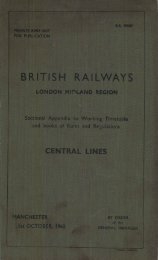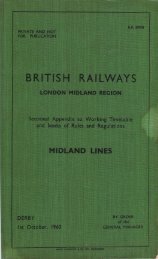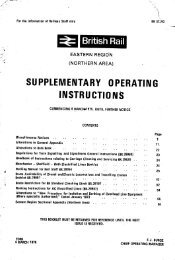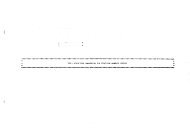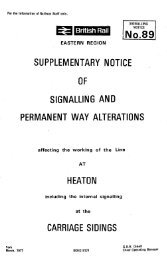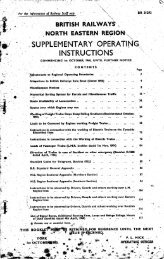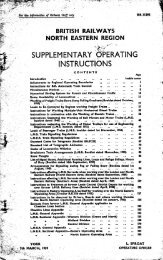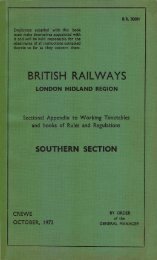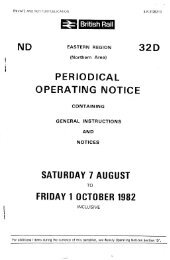general instructions. - Limit Of Shunt
general instructions. - Limit Of Shunt
general instructions. - Limit Of Shunt
Create successful ePaper yourself
Turn your PDF publications into a flip-book with our unique Google optimized e-Paper software.
152 G e n i a l Insinntions.—Continued.<br />
WORKiNG OF AUTOCARS.<br />
General Rule 170 (a).<br />
Guards of Autocar trains, when a car is running first, must, in all cases,<br />
ride in the Guard's compartment adjoining the Driver's compartment.<br />
(O. 1028).<br />
CLEARING OF LUGGAGE COMPARTMENTS AND VANS AT<br />
TERMINAL STATIONS.<br />
General Rule 170 (c).<br />
On the arrival of trains at terminal stations, Guards must see that the<br />
luggage compartments and vans on their trains have been cleared.<br />
GUARDS JOINING OR LEAVING PASSENGER TRAINS<br />
ON THE JOURNEY.<br />
General Rule 171-<br />
Whenever an additional guard joins a train on the journey to work a<br />
van which is nearer the engine than that in which the other guard is travelling,<br />
the additional guard must, as soon as the train has come to rest, and<br />
before he joins the van, inform the driver that he will give him the signal<br />
to start, and also advise him how far he will accompany the train.<br />
When a guard leaves a train on the journey, and the signal will afterwards<br />
be given by a guard nearer the rear, he must inform the driver before<br />
reaching the station at which he will leave, or as soon as the train stops at<br />
that station, that he is leaving. ( 0 , 5571).<br />
SHUNTING OF TRAINS.<br />
General Rules 175 and 187.<br />
Station Masters, Inspectors, Yard Foremen, Signalmen, Guards, and<br />
Drivers are 'required to note the following <strong>instructions</strong> with reference to<br />
the shunting and starting of trains :—<br />
1.—Where telegraphic communication and relief sidings are provided,<br />
Station Masters, inspectors, Yard Foremen, and Signalmen at stations or<br />
boxes have authority to order that trains be shunted and detained to the<br />
extent necessary to avoid detention to more important trains. Where telegraphic<br />
communication and relief sidings are not provided, the responsibility<br />
as to shunting and detention of trains will rest with the drivers and guards,<br />
but the signalman, station master, or person in charge, must call the driver's<br />
and guard's attention to the fact of any more important train being due<br />
or nearly so, when such is the case.<br />
2.—Passenger trains must not be passed over loose points in the facing<br />
direction unless they are clamped, subject to this single exception, that<br />
autocars may pass over them for the purpose of attaching and detaching,<br />
if they are secured by chock or common rail keys.<br />
S.—Before a loaded passenger train or vehicles (except autocars) containing<br />
passengers are shunted over loose points for the purpose of attaching or<br />
detaching, care must be taken to see that the points are in all cases made<br />
secure by means of the clamp.<br />
4.—It must be understood that a signalman shall allow a train to precede<br />
a passenger or other train upon the request of a Station Master or foreman<br />
in charge of the goods yard or sidings, the responsibility in these cases resting<br />
with the latter.




